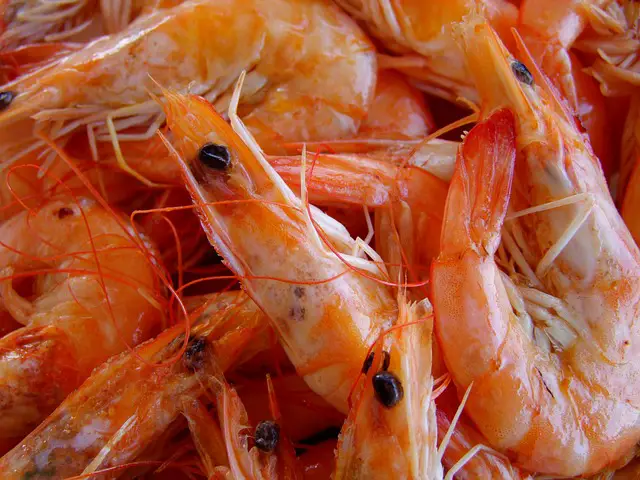Shrimp scampi is a classic seafood staple across many Italian-American restaurants. Learn everything about it’s origins, and the exact method used for its early preparations.
What is shrimp scampi?
Shrimp scampi is a variation of the Italian “scampi” dish that substitutes the “scampi” part of the dish with fresh shrimps. The scampi is just another species of crustacean incase you’re wondering. The genesis of this dish is tied with the United States and its early Italian immigrants. Or put simply, the Italian-Americans!
These immigrants were accustomed to preparing the scampi dish with crustaceans of the Nephrops Genus, also known as scampi, or langoustine in French, but as they migrated over to the United States, the scampi species weren’t readily available in the market, so they resorted to adapting their Italian techniques with American ingredients.
They found shrimps, branded the recipe into “shrimp scampi” (which actually makes no sense if you really think about it), and the new recipe worked its magic ever since then.
Nowadays, several variations of the original shrimp scampi delicacy can be found in different parts of the United States.
There is now a type of shrimp scampi made with chicken parts, and some with a wide variety of crustaceans like scallops, crayfish, and many species of lobsters. There is even a type of shrimp scampi that substitutes the shrimps with roasted veggies like asparagus in order to accommodate vegan and vegetarian audience.
The variation doesn’t only stop with the type of meat used for preparation. There are also differences observed in the type of methods used in the preparation, the ways of serving the dish, as well as the ingredients employed in cooking it. We’ll discuss them below.
The origin of shrimp scampi
Shrimp scampi is an American invention by Italians. What…? Yes, i just said that. And wait for it… It’s 100% true! Early Italian immigrants in the United States invented the Shrimp Scampi back then in the late 19th to early 20th century.
In the Italian language, scampi is the plural form of the word “scampo” used to referred to a certain type of crustacean called “langoustine” which on the surface, is nothing but another variation of the lobster family. This crustacean is traditionally prepared in Italy by quickly sautéing it in a sauce containing butter, olive oil and garlic, and then serving with pasta or rice.
The way the “shrimp scampi” name came into being was as follows: Italian Immigrants of the 19th to 20th century (the exactness is still obscure), well accustomed with their staple scampi dish found new problem in their newly settled home and quickly adapted to solve the problem.
In the United States, they were no scampi that were readily available in the market because sourcing them out was quite a challenge due to their distant geographical distribution from the United States paired with their unimpressive shell life.
But there were other crustaceans that were not far away from scampi both in terms of taste and looks, so these immigrants incorporated what was readily available to them in the form of shrimp, and then decided to call the altered recipe “shrimp prepared scampi-style”. Over time, the name was shortened to the convenient “shrimp scampi”, and till this day, the name has persisted.
But glorious as the dish is, the name actually makes no sense. It’s like saying: goat, dog, or boy, girl. Regardless, it’s still a name that we somehow understand, and the dish is a masterpiece that has come to stay.
What exactly is scampi?
Scampi (Nephrops norvegicus) is one of the many types of sea crustaceans belonging to the lobster family. It’s a spiny, hard shelled creature that resembles shrimps and also has a pink shell.
The coloration can also be described as powdered pink. The most notable characteristic of scampi is that it has meat on its tail section but not as much in its claws, and Scampi can be found in the northeastern Atlantic (regions spanning from North Africa all the way to Iceland, including some parts of the Mediterranean Sea, although they’re currently not as abundant as they once used to be in that region).
Scampi is also known as the Norway lobster, Dublin Bay Prawn, langoustine (in French) and Cigala (in Spanish), and its closest relatives are other lobsters of the Metanephrops genus also casually referred to as Scampi. They include the Australian Scampi and the New Zealand scampi.
How is the typical shrimp scampi made?
The most popular method for preparing shrimp scampi is by sautéing it with olive oil, garlic, onion, and dry white wine, until a delightful tenderness and flavor is achieved, then serving with linguine (or other types of pasta), Parmesan cheese, bread, rice, or just the scampi alone.
This is exactly what the traditional scampi recipe of Italian origin looks like, although scampi in the united kingdom usually means the preparation of this lobster by cooking it in breadcrumbs or batter and serving with chips or sauce.
Recent variations of this method (shrimp scampi) includes the addition of flavored butter, lemon, lemon zest, crustacean stock, tomatoes, breadcrumbs, pepper flakes, and herbs like parsley and tarragon.
Adornments such as grapes and pears can also be platted alongside the scampi dish, or servings like chips, pasta, rice, parmesan cheese, bread and tartar or tomato sauce.
The vegetarian version also exists which simply replaces the “shrimp” with grilled asparagus or other veggies.
The traditional way of making shrimp scampi
The traditional method of making shrimp scampi uses fresh shrimps to impart a slightly sweet flavor to the final dish. This flavor is typically lost when shrimps are frozen. Shrimp shells may or may not be used, but their presence in the sauce can help boost flavor.
For the method, first, butter is melted with olive oil in a large skillet and garlic is sautéed in the mixture until it begins to exude fragrance. Next, court bouillon broth or wine is added to the mixture and seasonings (like ground red and black pepper, salt and pepper flakes) are used to kick life into the mixture, and then the sauce is left to simmer on the heat until reduced by half.
Next, prepared shrimps are added with or without their shells and sautéed for a couple of minutes depending on their size, until they turn pink. Lastly, some quick sprinkle of chopped parsley or other herbs is done over the mixture and voila, the dish is ready to pair with a crusted bread or a slightly firm pasta.


